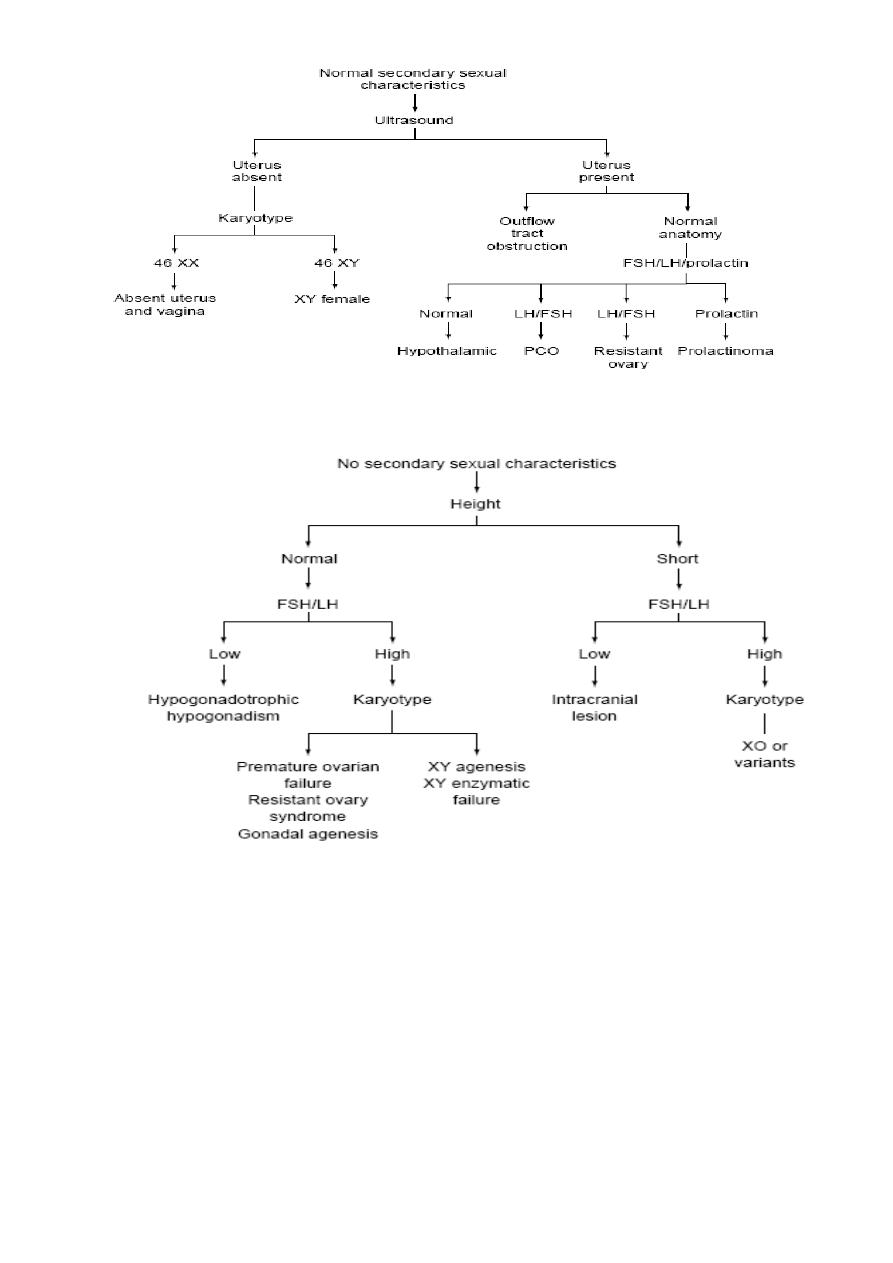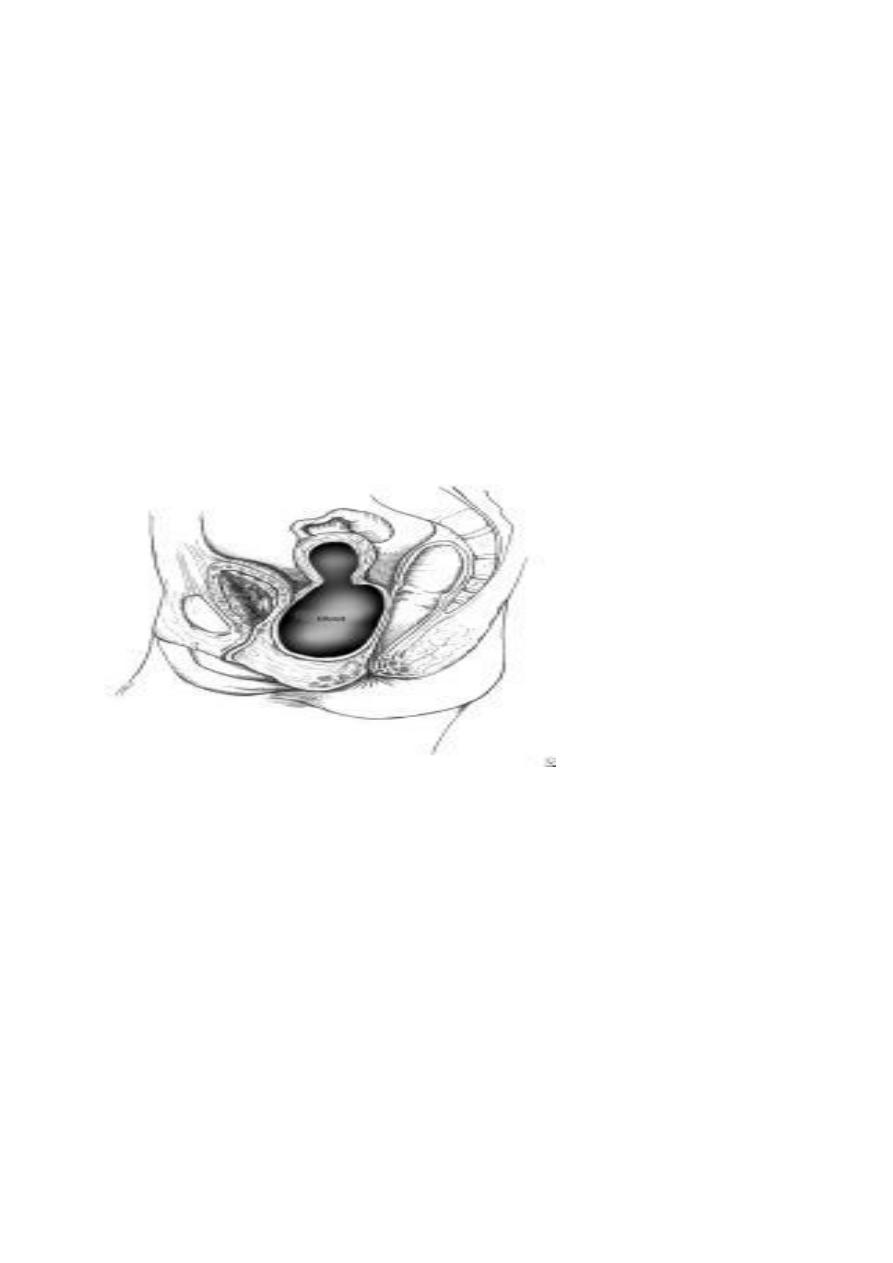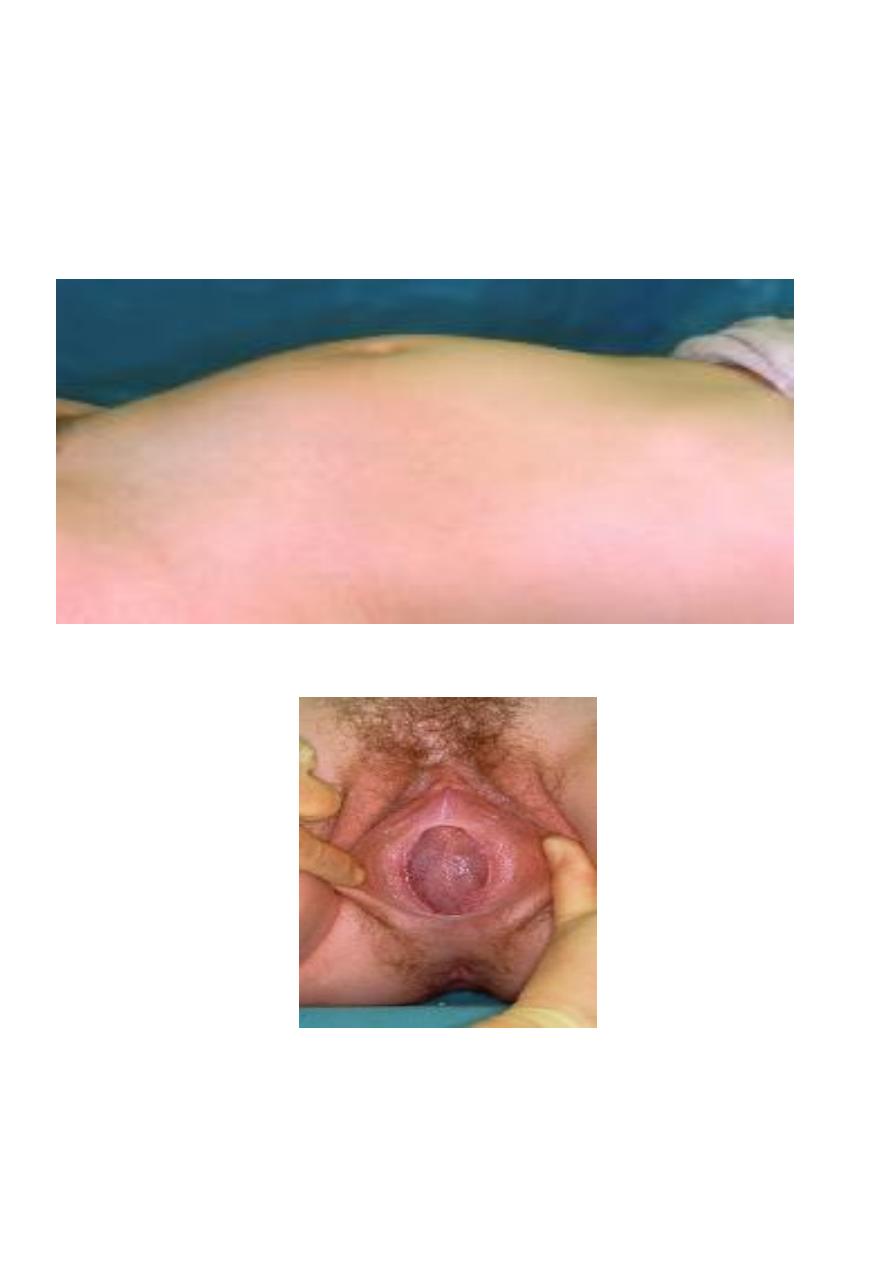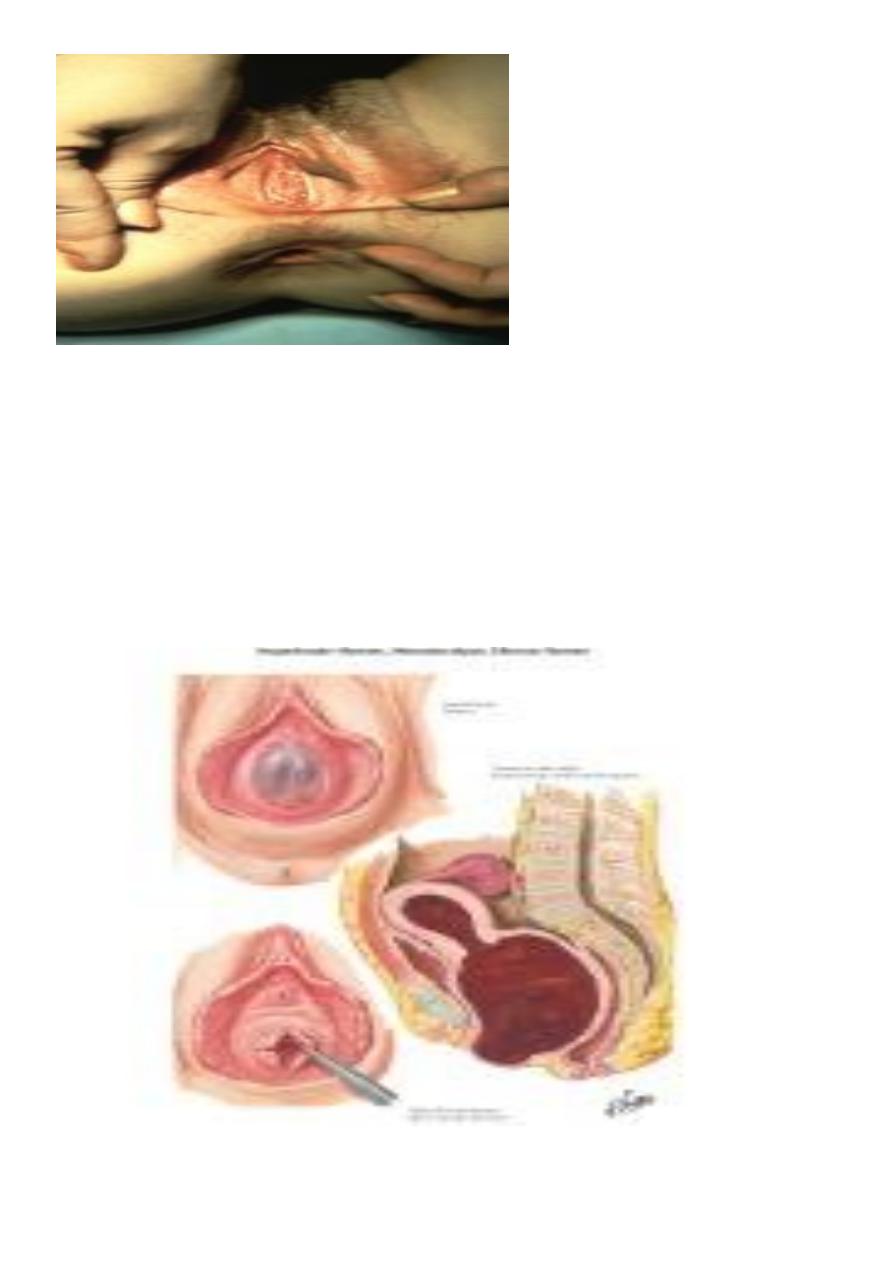
1
Fifth stage
Gynecology
Lec-1
د. احمد جاسم
2/11/2015
amenorrhoea
GENERAL OBJECTIVE
Students will understand amenorrhoea and types and causes as well as management.
Specific objectives
After attending lecture, the student will can:
Know what is the amenorrhoea and it’s types.
List causes of primary amenorrhoea.
Given patient history ,examination and a set of laboratory data, correctly diagnose the disease.
(problem-solving).
Discuses treatment.
Amenorrhea
Amenorrhea is the absence of menstruation. Amenorrhoea can be classified as:
A. Physiological :
1.Before puberty.
Oestrogen level is not sufficient to promote adequate endometrial development to
cause bleeding.
2. During pregnancy.
3. During lactation.
The average time between delivery and the first subsequent period and associated
Ovulation is:
10-14 weeks in those patients who do not breast-feed their infants.
In those with breast feeding ,it depends on duration of breast feeding.
During lactation, Prolactin is secreted in large amounts by anterior pituitary gland
and there is suppression of LH secretion so the ovarian follicles may mature but fail
to rupture.
4. After the menopause.
Cessation of oestrogen production from the ovary due to no graffian follicles in
ovary.

2
B. Pathological: can be classified as:
Primary amenorrhoea: No spontaneous uterine bleeding has occurred.
Secondary amenorrhoea: cessation of the periods after menstruation has been
established for more than six months in a normal female of reproductive age that is
not due to pregnancy.
Primary amenorrhoea
No spontaneous uterine bleeding has occurred by the age of: *14(13) years in the
absence of secondary sexual characteristic or *16 years in presence of secondary sexual
characteristic.
Aetiology of primary amenorrhoea :
classify the etiologies of primary
amenorrhoea based on the presence or absence of secondary sexual characteristics.
A/ primary amenorrhoea with secondary sexual development:
4.
Out flow obstruction:
Imperforate hymen.
Transverse vaginal septum.
Cervical agenesis.
2. uterine causes
:
Mullerian agenesis (Absent uterus (Rokitansky syndrome).
Surgical removal of the uterus.
Damage after radiotherapy.
Asherman's Syndrome (very rare in primary amenorrhoea)

3
3. Complete androgen insensitivity syndrome (46XY) (testicular feminization).
4. Ovarian cause: (unusual)
Anovulation:
a. poly cystic ovary syndrome (PCO)
b. Hyperprolactinemia.
Premature ovarian failure.
Resistant ovary syndrome.
Surgical removal of the ovaries.
exposure to radiation.
5.Pituitary disorders:
Pituitary adenomas.
Sheehan's syndrome.
6 -- :
Hypothalamic disorders:
a. Space occupying lesion: crainopharyngioma, tuberculosis, sarcoidosis.
b. Congenital GnRH deficiency leads to low gonadotropin levels. When this
occurs with anosmia, it is diagnosed as Kallman syndrome.
Weight loss. Anorexia nervosa.
Excessive exercise.
Environment : Sudden change in the environment as in change of residence or in
occupation can cause amenorrhoea.
Emotional upsets and mental stress. Stress during examination can also cause loss
of menses.
major psychiatric disorders such as Psychoses, depression.

4
7.Pregnancy.
8. Idiopathic. Constitutional delay
9. Other causes :
Thyroid: (hypothyroidism and hyperthyroidism)
Diabetes mellitus.
Adrenal Tumours.
Chronic diseases.
B . primary ammenorrhoea without secondary sexual development (sexual
infantilism):
Patients with primary amenorrhoea and no secondary sexual characteristics display the
absence of gonadal hormone secreation.
*Gonadal agenesis and dysgenesis (including Turner syndrome).
*Delayed puberty. (Constitutional).
*Anorexia nervosa. (if it occurred before development of secondary sexual
characters)
*17 alpha-hydroxylase deficiency. (Prevent synthesis of sex steroids).
Diagnoses unique to primary amenorrhea include:
vaginal agenesis.
androgen insensitivity syndrome.
Turner syndrome (45,X).
The remaining causes should be considered in patients with primary amenorrhea and in
patients with secondary amenorrhea.
Note: unique main only present in primary amenorrhoea.
Management:
1. History :
An adequate history includes:

5
Childhood growth and development including height and weight charts and age at
breast development if present.
Presence or absence of cyclical symptoms mainly abdominal pain, difficulties in urination
and even urinary retention, difficulties in defecation. (Outflow obstruction).
Excessive weight loss/ presence of eating disorder.
Excessive exercise.
psychosocial condition should be known.
vasomotor symptoms, hot flushes, virilizing changes, galactorrhea, fatigue, palpitations,
nervousness, headache, hearing loss, and visual changes.
Family history of anosmia, androgen insensitivity in family as it may affect other females
in the family and ascertaining the age at menarche of the patient's mother and sisters is
advisable because the age at menarche in family members can occur within a year of the
age in others.
Any history of chronic illness, trauma, surgery, and medications is also important.
A sexual history should be obtained if married.
2. Physical examination:
Pituitary infantilism due to lack of growth hormone.
Turner’s syndrome. (Webbed neck, increased carrying angle, lack of breast
development, and short stature).
-The girl's stature may be tall which may be due to androgen insensitivity.
Girl weight and calculate her body mass index (BMI).
*development of secondary sexual characteristic (breast development, axillary and
pubic hair growth).
Any evidence of abnormal virilization (as clitromegally) as seen in Adrenal or ovarian
tumors.
hirsutism.
Fundoscopy examination, visual filed examination and neurological examination if
pituitary tumour is suspected.
Breast examination:
Look for presence of breast and its stage of development.

6
Presence of Galactorrhea.
Pelvic examination:
Should be undertaken in the presence of the patient’s mother.
Inspect vulva to see opening of introitus (opened, closed by bluish membrane, closed)
A bimanual examination is inappropriate (contraindicated) in unmarried girl.
Furthermore, it may be more appropriate to defer this from the first consultation to
assure the patient’s confidence in future management and in most cases information
taken from transabdominal ultrasound examination of the pelvis.
Rectal examination shows the absence of uterus.
3. Investigations:
Start investigation in cases with primary amenorrhoea
14 years in the absence of secondary sexual characteristic
16 years in presence of secondary sexual characteristic
in some circumstances, it is reasonable to initiate an evaluation despite the
absence of the above strict criteria as:
a) in patient with the stigmata of Turner syndrome.
b) in patient with obvious virilization.
c) in a patient or her parents are concerned.
The history and physical findings help in selecting tests in a female patient with
amenorrhea.
Chromosomal analysis:
In uncertain diagnosis, full chromosomal analysis and Karyotype should be done.
In Karyotype A buccal smear and examination of the polymorphnuclear leucocytes to
determine if chromatin positive (XX) or chromatin negative (XO or XY) and some time
full chromosomal analysis may be needed.
Investigation for chronic illness:
If the history or physical findings suggest a chronic disease process, the following may
be indicated including measurement of the erythrocyte sedimentation rate (ESR),
liver function tests, renal function test and urinalysis.

7
should include follicular stimulation 7ormone (FSH),lutinizing hormone ( LH),
oestradiol, testosterone, Prolactin, thyroid function test, growth hormone ,
adrenocorticotropic hormone (ACTH).
The result in hypothalamic or pituitary cause is low FSH, LH, oestradiol.
The results in ovarian cause are high gonadotrophin and low estrogen.
Imaging studies:
*Ultrasound:
Determine the presence, state and size of ovaries and any follicular activity.
Determine the presence and size of uterus.
Congenital anatomic abnormalities of uterus or vagina or both are often associated
with renal abnormalities such as unilateral solitary kidney so these patients should
have intravenous pyelogram.
*a coned view of the sella turcica or MRI of the pituitary is indicated.
*Bone age X ray to determining bone age which is important in differentiating
pubertal delays as a cause.
*Laproscopy
Laproscopy rarely used to assess pelvic organ. It is useful in:
* cases which there is doubt about the nature of the gonads.
*cases where ovarian biopsy is needed to determine presence of primordial oocytes.
Most of the conditions are rare and constitutional delay without doubt is the most
common diagnosis. However, as the rest of the diagnoses have serious implications
this diagnosis of constitutional delay should only be made when all other
syndromes have been excluded. Constitutional delayed puberty is a diagnosis of
exclusion.

8
Investigative pathway for a patient with normal sexual characteristics
Investigative pathway for a patient with no secondary sexual characteristics
4.
Treatment:
No attempt should ever be made to treat patients with primary amenorrhea until a firm
diagnosis is reached.
1.Patient with sexual infantilism (without secondary sexual charcteristic)
Cases of Turner's syndrome

9
Induce breast development by very gradually increasing oestrogen doses then change to
definitive treatment of hormone replacement therapy (estrogen and progestrone). They
have no hope to achieve pregnancy.
In hypogonadotrophic hypogonadism who seek fertility will need therapy with either
human menopausal gonadotrophin injection or gonadotrophin releasing hormone
(GnRH).
In 17-hydroxylase deficiency have no hope to achieve pregnancy.
2.Patient with primary amenorrhoea with secondary sexual development:
androgen insensitivity :
1. Excision of gonads as this gonad is a testis and there is a malignant potential in about
30% of cases
2. Creation of neovagina to permit sexual intercourse.
3. Treatment with oestrogen to augment breast development and prevent osteoporosis.
4. Psychological support.
5. Those women are unable to be fertile at all.
Imperforate hymen
Treated by hymenectomy.
Transverse vaginal septum
Surgical correction is indicated but difficult technique is needed.
Cervical agenesis:
Hysterectomy is recommended.
3.Constitutional delay
Girls in whom normal secondary sexual characteristics exist. There is no anatomical
anomaly and endocrine investigations are all normal. It is reasonable to await events as
these young women will eventually menstruate spontaneously as the maturation
process proceeds. There is no need to suggest any treatment other than annual review.
In some circumstances it may be useful to promote a menstruation using the oral
contraceptive pill for one cycle to prove that menstruation can occur and this can be
extremely reassuring.
Other causes treated as it is (discussed in specific subject lectures)

11
The imperforate hymen may present at two ages of development. It may present in: Early
childhood :
When the infant presents with a bulging hymen behind which is a mucocele, the vagina
expanded by vaginal secretions of mucus. Treated by hymenectomy and does not
subsequently cause any problems following hymenectomy.
At puberty :
The very distensible features of vagina allow quite large quantities of blood to collect in
some cases. This situation is known as haematocolpos.
When some blood does accumulate within the uterine cavity it is known as a
haematometra.
Diagram of hematometra and hematocolpos with imperforate distal transverse vaginal
septum
History:
A pubertal girl complains of intermittent cyclical abdominal pain. The pain is due to
dysmenorrhoea associated with the accumulation of menstrual blood within the vagina. As
the mass enlarges there may be associated difficulty with micturition and defaecation and
even associated with retension of urine in some cases.

11
Examination:
Normal stature and have normal secondary sexual characteristic.
Abdominal examination will reveal on occasions an abdominal swelling
Pelvic examination by inspection of external genitalia showed a tense bulging bluish
membrane (which is the hymen) closing the introitus.
Abdominal mass with imperforate hymen
observation of the introitus will display a tense bulging bluish membrane which is the
hymen.

12
Vaginal agenesis Not to be confused with Imperforate hymen
Investigation:
Ultrasound showed blood collection in vagina and uterus.
Treatment:
After explanation of the condition and obtaining parents consent, a cruciate incision (+) in
the hymen allows drainage of the retained menstrual blood. From medico-legal point of
view, the girl must be given a report confirm that the hymen was opened by surgical
operation as treatment.
